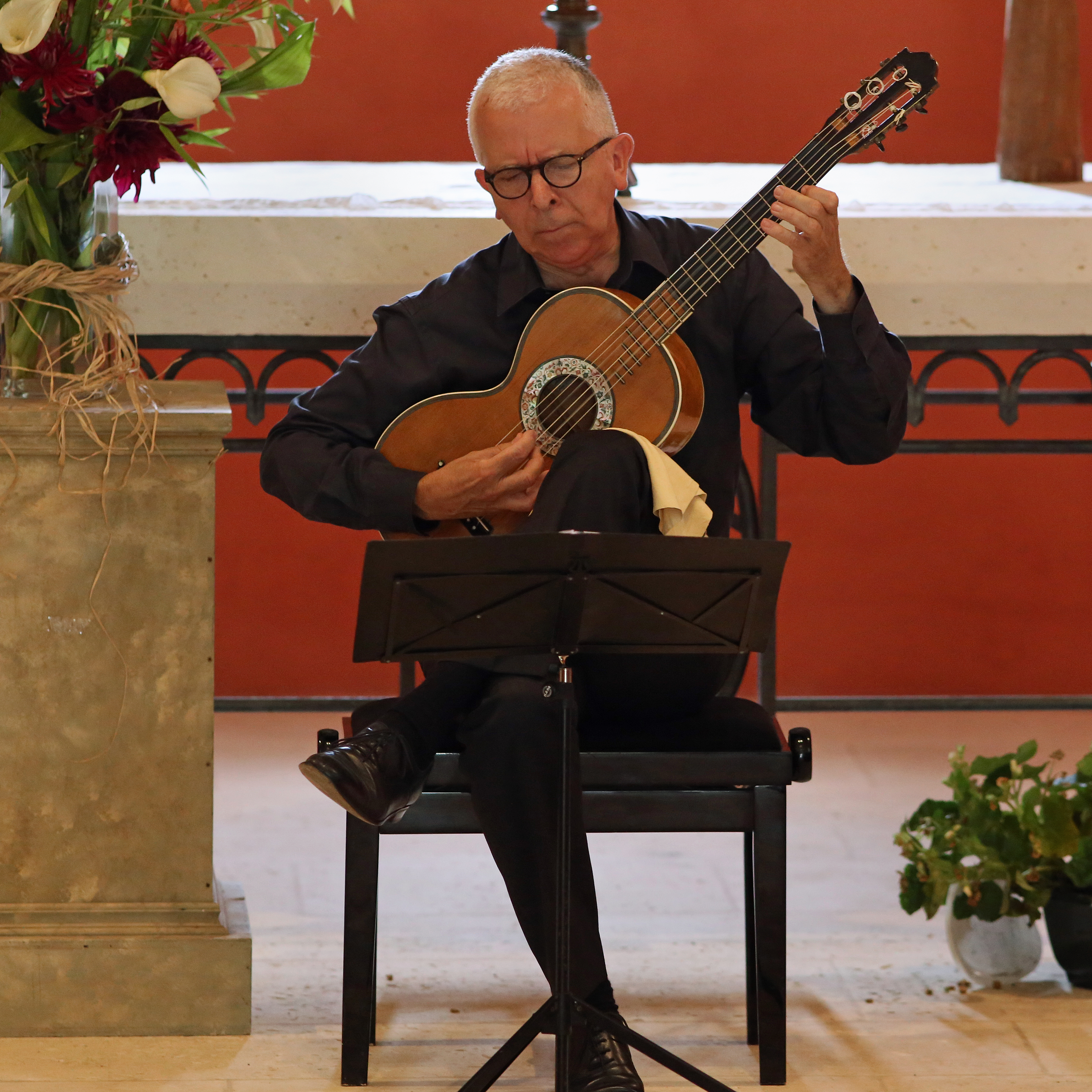D James Ross at the Edinburgh International Festival 2018
A Pair of Period Pianos
To be able to host two of the four ‘big beasts’ of the early piano world within four days of one another is the prerogative of an international festival, and we were uniquely privileged to be able to compare recitals by Ronald Brautigam and Robert Levin at Edinburgh’s attractive Queen’s Hall. Brautigam was playing a beautiful Erard piano of 1837 from the collection of Edwin Beunk, an instrument which was a feast for the eyes much admired by the audience before the recital even started. It turned out to be an equal aural treat, when Brautigan opened his performance with Mendelssohn’s Rondo capriccioso. A full tone in the middle register, with an added edge in the bottom range and a delightfully light upper register allowed the instrument to reveal the innermost secrets of the works by Mendelssohn and Chopin which made up the programmne, while Brautigam’s stunning technique and deft pedalling provided further revelations. Chopin’s B flat minor Scherzo op. 31 provided a brilliant introduction to the two Nocturnes of opus 27, where I have never heard the distinctive undulating arpeggios performed with more clarity and eloquence. Mendelssohn’s impressive Variations sérieuses op 54 brought the first half to a spectacularly virtuosic conclusion.
The Six Songs without Words op 19 proved a wonderfully melodic opening to the second half, with the venerable Erard fairly singing out Mendelssohn’s lyrical melodies, while Chopin’s op 60 Barcarolle and op 57 Berceuse continued in a similarly gentle vein. Brautigam’s wonderfully compelling and flamboyantly executed performance concluded appropriately with Chopin’s showy Polonaise-fantaisie op 61 – a compositional and performance tour de force. A further delightful Barcarolle provided a suitably calming encore.
The Queen’s Hall also hosted an all-Mozart recital by Robert Levin, this time on a modern copy by Paul McNulty of an 1805 fortepiano by Anton Walter & Sohn. The contrast in sound between this instrument and the 1837 Erard was striking, as Robert Levin conjured wonderfully silvery tones from an instrument which turned out to have a wonderfully percussive bass register and a charmingly rapid decay. In his witty verbal introduction, Levin cited a keyboard tutor by CPE Bach in which he advocates lavish ornamentation of repeats and valuably provides examples, which prove to be radical departures from the originals. Levin pithily explained why he was playing from printed music – ‘I need to know what not to play in the repeats!’ With improvisation high on the agenda, Levin had compiled an ingenious programme juxtaposing three Mozart sonatas with the composer’s flamboyant Four Preludes K284a. The recital opened a short piece reconstructed by Levin from a liminal fragment notated in a manuscript of the composer’s Grabmusik. The cascades of scales and arpeggios in the Preludes seemed to prefigure the keyboard fireworks of Chopin, and surely provide us with a rare window on Mozart’s much-admired skills as an improviser. Levin’s own stunning powers of improvisation in the repeat sections of the Sonatas were nothing less than breathtaking, surely showing the way for future performances of these concert staples. Mozart’s own piano arrangement of the overture to Die Entführung aus dem Serail gave full rein to the clashing bass register, seeming almost to beg for one of the pianos of the time which featured Turkish percussion effects! If Levin’s laudable decision to group the pieces together and his slightly annoying mannerism of rushing to cadences led to a slightly breathless impression, this was a recital which was never less than exciting and frequently absolutely thrilling. An enthusiastic ovation elicited an unusual encore – Levin had transcribed the music from the famous portrait of the boy Mozart in red livery and looking hauntingly straight at the viewer. It turned out to be a youthful showpiece, surely designed to advertise the boy’s precocious compositional skills.
A Biblical Epic
If you will forgive the innuendo, Samson uncut is surprisingly huge. This became apparent as we sat down to the Dunedin Consort’s performance of Handel’s oratorio, which was projected to last no less than four hours. Written around the same time as Messiah, Samson has never enjoyed the success it deserves, and with the exception of the last two numbers, the spectacular show-aria Let the Bright Seraphim and the ensuing chorus Let their Celestial Consorts all unite little of the music has entered the standard repertoire. As I sat through a series of very fine arias and choruses I found myself musing upon why this vintage Handel isn’t more mainstream. One problem is that all the drama happens off-stage – Samson is already blinded and defeated when we first encounter him, and the concluding destruction of the temple is reduced to ‘noises off’. The unrelentingly melancholy subject, only very latterly transformed to triumph, also makes for painful listening. I found myself tearing up as Samson considered his blindness, singing heartrending words by blind Milton to moving music by Handel, already losing his sight, and who also would be blind within a few years. Paul Appleby’s account of the air Total Eclipse, as indeed his interpretation of the complex character of Samson, was immensely powerful, while his vocal technique in a long and demanding role was stunning. Sophie Bevan in the dramatically thankless role of Delila was simply superb as she purred, trilled and cooed her way through her seduction aria With plaintive notes, earning her the only individual ovation of the evening. Matthew Brook’s well-gauged Manoa, Samson’s father, was a powerful presence. Alice Coote, by contrast, seemed less comfortable in the role of Micah, composed by Handel for Mrs Cibber, although she did grow into the part as the piece advanced. Mhairi Lawson was an excellent stand-in second Philistine/Israelite Woman, and Hugo Hymas was vocally well cast as Israelite/Philistine Man. Of course, Louise Alder gets the best music in the show, Let the Bright Seraphim, a wonderfully sparkling show-stopper of an aria with obligato clarino trumpet, which is a gift to a soprano with the technique to enjoy it to the full. Wisely employing the Harry Christophers solution of segueing from the b-section of the aria straight into the concluding chorus ensured that the piece came to a terrific climax, and a deafening and extended ovation from the Usher Hall audience
As always with the Dunedin forces it seems, the orchestral playing was consistently superb under the detailed direction of John Butt, with wonderfully expressive string playing and fine contributions from bassoon, oboes, trumpets and a pair of wonderfully rumbustious horns, not always pinpoint accurate but infectiously energetic. Thomas Pitt and Stephen Farr provided unerringly supportive continuo playing, while the latter was also the organ soloist in the movements from Handel’s organ concertos that graced the intervals. This was a fascinating Dunedin experiment, copying Handel in filling intermissions with instrumental works, on this occasion on a copy by Goetz and Gwynn of an organ owned by Handel’s librettist Jennens, during which the audience was encouraged to walk around and chat. You will be pleased to hear that your reviewer selflessly eschewed a visit to the bar to move to the front to hear the organ more clearly! Perhaps the ultimate jewel in the crown of this superb performance was the singing of the Dunedin Consort chorus, twenty-four young singers who produced an impeccably accurate and wonderfully gleaming sound throughout. This was a lot of Handel to take in at one go, but it was very good Handel and wonderfully performed by Edinburgh’s local Baroque heroes, the Dunedin Consort.
A Beggar’s Opera for our times?
As the late great Nikolaus Harnoncourt said in a verbal introduction to a period performance of Haydn’s Surprise Symphony, ‘What would musicians have to do to surprise an audience to the same degree as an audience of the time was surprised by a loud chord?’. Leaving the question hanging, he started the piece, letting off a loud indoor firework at the relevant moment in the slow movement, smiling conspiratorially as the audience, aware of the recent terrorist bombings, screamed in shock. In many ways it is depressing how easily Gay and Rich’s social satire, The Beggar’s Opera transfers to our own times. However the version performed in the King’s Theatre by the instrumentalists of Les Arts Florissants and the actors of Théâtre des Bouffes du Nord used a modernised edition by Ian Burton and Robert Carson in which much ‘f-ing and blinding’, street dancing, drugs deals, texting and social networking sought to place the piece in the same shocking relationship with a modern audience as the original work had enjoyed with the 18th-century public. And I think with a few reservations that it succeeded very well.
The stage was filled with a sheer cliff face of cardboard boxes at the foot of which slept a beggar, and through the action the boxes provided a very serviceable set of props and settings for the action. An onstage band of period instrumentalists sat at boxes with tablets propped up on them with their music, and provided beautifully energetic accounts of the ballad airs and dances. The singing actors of the cast coped generally very well with the musical aspects of the show, although just once or twice the geography of the set led to timing or tuning going a little adrift. Evoking a mixture of Eastenders and TOWIE (Google it…), Robert Burt as Peachum and Beverley Klein as his wife provided wonderfully sleazy central characters, always teetering on the edge of violence. Kate Batter’s vulnerable but equally sleazy Polly and Benjamin Purkiss’s dashingly macho Macheath were strongly characterised, while the host of whores, gangsters and corrupt officials that seethe around them were vividly brought to life by a gifted and versatile cast. The athletic street dancing of the behoodied gang was particularly effective.
To my mind, it was a mistake to cut the Beggar and his prologue, as the lack of framework left a problem at the end, not convincingly solved by a change of government and all the beggars becoming cabinet ministers – ironically not as preposterous a conclusion as Gay and Rich’s original cynically contrived ending. Indeed the wit and cynicism of the 18th-century original shone through this performance, which remained almost entirely true to the narrative and many of the resonances of the text, while retaining the original song texts with just a few minor tweaks. As promised in the promotion, the musical dimension did have a fine improvisatory quality, in which the two Baroque violins, viola, cello and double bass joined by a recorder, an oboe, an archlute and percussion all directed from the harpsichord by Florian Carré sounded wonderfully spontaneous and energetic. If the band occasionally came across as a little underpowered against the ‘mic’d up’ voices in the theatre acoustic, the playing was always wonderfully expressive and imaginative, with very effective elaborations and ornamentation.
This riotous outing at the end of my Festival visit seemed a million miles away from the world of the elegant period piano recitals with which I have begun, but this has got to be the chief joy of an international festival, which can offer such variety even within the realm of early music. And bear in mind that while I was attending events in the ‘official’ Festival, on the Fringe elsewhere in town the Edinburgh Renaissance Band were wowing the crowds with innovative early programmes, and Cappella Nova were filling Greyfriars Kirk with the distinctive tones of Robert Carver!
D. James Ross






